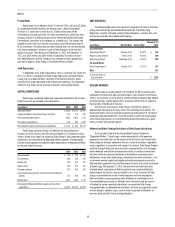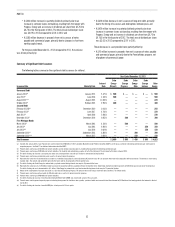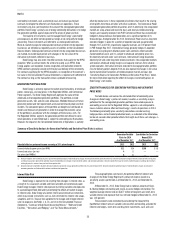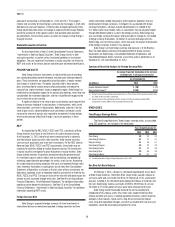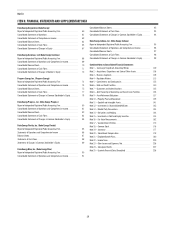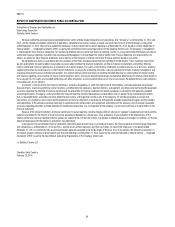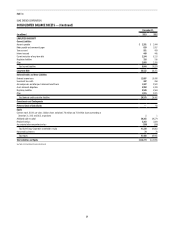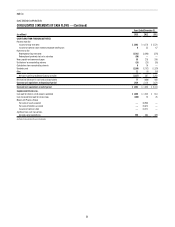Duke Energy 2013 Annual Report Download - page 74
Download and view the complete annual report
Please find page 74 of the 2013 Duke Energy annual report below. You can navigate through the pages in the report by either clicking on the pages listed below, or by using the keyword search tool below to find specific information within the annual report.
56
PART II
equivalents outstanding as of December 31, 2013 and 2012. The change in
interest rate sensitivity for Duke Energy is primarily due to changes in short-term
debt balances and cash balances. If interest rates changed significantly, Duke
Energy would likely take actions to manage its exposure to the change. However,
due to the uncertainty of the specific actions that would be taken and their
possible effects, the sensitivity analysis assumes no changes in Duke Energy’s
financial structure.
Marketable Securities Price Risk
As described further in Note 15 to the Consolidated Financial Statements,
“Investments in Debt and Equity Securities,” Duke Energy invests in debt
and equity securities as part of various investment portfolios to fund certain
obligations. The vast majority of investments in equity securities are within the
NDTF and assets of the various pension and other post-retirement benefit plans.
PENSION PLAN ASSETS
Duke Energy maintains investments to help fund the costs of providing
non-contributory defined benefit retirement and other post-retirement benefit
plans. These investments are exposed to price fluctuations in equity markets
and changes in interest rates. The equity securities held in these pension
plans are diversified to achieve broad market participation and reduce the
impact of any single investment, sector or geographic region. Duke Energy has
established asset allocation targets for its pension plan holdings, which take into
consideration the investment objectives and the risk profile with respect to the
trust in which the assets are held.
A significant decline in the value of plan asset holdings could require Duke
Energy to increase funding of its pension plans in future periods, which could
adversely affect cash flows in those periods. Additionally, a decline in the fair
value of plan assets, absent additional cash contributions to the plan, could
increase the amount of pension cost required to be recorded in future periods,
which could adversely affect Duke Energy’s results of operations in those
periods.
NDTF
As required by the NRC, NCUC, PSCSC and FPSC, subsidiaries of Duke
Energy maintain trust funds to fund the costs of nuclear decommissioning.
As of December 31, 2013, these funds were invested primarily in domestic
and international equity securities, debt securities, fixed-income securities,
cash and cash equivalents and short-term investments. Per the NRC, Internal
Revenue Code, NCUC, PSCSC and FPSC requirements, these funds may be
used only for activities related to nuclear decommissioning. The investments
in equity securities are exposed to price fluctuations in equity markets. Duke
Energy actively monitors its portfolios by benchmarking the performance of
its investments against certain indices and by maintaining, and periodically
reviewing, target allocation percentages for various asset classes. Accounting
for nuclear decommissioning recognizes that costs are recovered through retail
rates; therefore, fluctuations in equity prices do not affect their Consolidated
Statements of Operations as changes in the fair value of these investments are
deferred as regulatory assets or regulatory liabilities pursuant to an Order by the
NCUC, PSCSC and FPSC. Earnings or losses of the fund will ultimately impact the
amount of costs recovered through retail rates. See Note 9 to the Consolidated
Financial Statements, “Asset Retirement Obligations” for additional information
regarding nuclear decommissioning costs. See Note 15 to the Consolidated
Financial Statements, “Investments in Debt and Equity Securities” for additional
information regarding NDTF assets.
Foreign Currency Risk
Duke Energy is exposed to foreign currency risk from investments in
international businesses owned and operated in foreign countries and from
certain commodity-related transactions within domestic operations that are
denominated in foreign currencies. To mitigate risks associated with foreign
currency fluctuations, contracts may be denominated in or indexed to the
U.S. Dollar and/or local inflation rates, or investments may be naturally hedged
through debt denominated or issued in the foreign currency. Duke Energy may
also use foreign currency derivatives, where possible, to manage its risk related
to foreign currency fluctuations. To monitor its currency exchange rate risks,
Duke Energy uses sensitivity analysis, which measures the impact of devaluation
of the foreign currencies to which it has exposure.
Duke Energy’s primary foreign currency rate exposure is to the Brazilian
Real. The table below summarizes the potential effect of foreign currency
devaluations on Duke Energy’s Consolidated Statement of Operations and
Consolidated Balance Sheets, based on a sensitivity analysis performed as of
December 31, 2013 and December 31, 2012.
Summary of Sensitivity Analysis for Foreign Currency Risks
Assuming 10 percent devaluation in the currency
exchange rates in all exposure currencies
As of December 31,
(in millions) 2013 2012
Income Statement impact(a) $ (20) $ (20)
Balance Sheet impact(b) $(140) $(150)
(a) Amounts represent the potential annual net pretax loss on the translation of local currency earnings to the
U.S. Dollar in 2013 and 2012, respectively.
(b) Amounts represent the potential impact to the currency translation through Accumulated Other
Comprehensive Income (AOCI) on the Consolidated Balance Sheets.
OTHER ISSUES
Fixed Charges Coverage Ratios
The Duke Energy Registrants’ fixed charges coverage ratios, as calculated
using SEC guidelines, are included in the table below.
Years Ended December 31,
2013 2012 2011
Duke Energy 3.0 2.5 3.2
Duke Energy Carolinas 4.2 3.7 3.7
Progress Energy 2.1 1.6 2.1
Duke Energy Progress 3.6 2.2 4.2
Duke Energy Florida 2.7 2.3 2.8
Duke Energy Ohio 2.8 3.4 3.4
Duke Energy Indiana 4.1 0.1 2.2
(a) Includes the results of Progress Energy beginning on July 2, 2012.
Dan River Ash Basin Release
On February 2, 2014, a break in a stormwater pipe beneath an ash basin
at Duke Energy Carolinas’ retired Dan River steam station caused a release of
ash basin water and ash into the Dan River. On February 8, 2014, a permanent
plug was installed in the stormwater pipe stopping the release of materials into
the river. Duke Energy Carolinas estimates 30,000 to 39,000 tons of ash and
24 million to 27 million gallons of basin water were released into the river.
Duke Energy cannot reasonably estimate the cost associated with
remediation of this release at this time. Other costs related to the Dan River
release and other ash basins, including regulatory directives, natural resources
damages, future lawsuits, future claims, long-term environmental impact
costs, long-term operational changes, and costs associated with new laws and
regulations cannot be reasonably estimated at this time.





